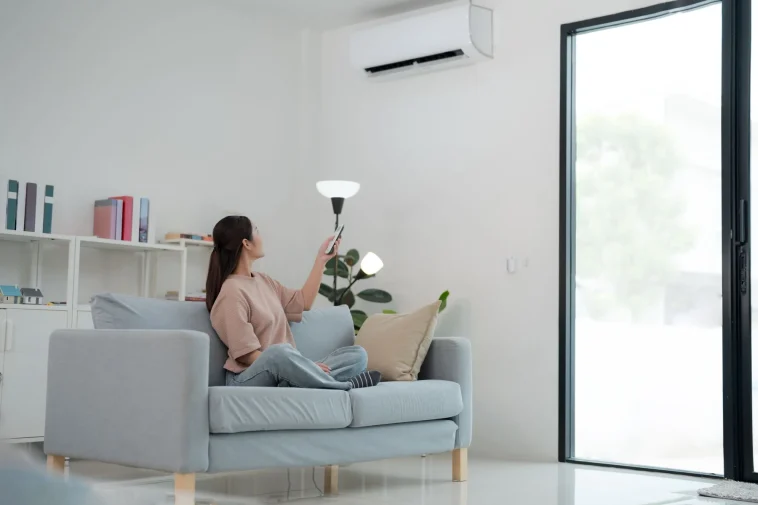When moving to a new city—whether for work, study, or a fresh adventure—one thing most people don’t think about is indoor air quality. But it can make a big difference in your health, sleep, and overall well-being. If you’ve ever wondered why your nose feels stuffy in a rental property or why certain places make you sneeze nonstop, poor air quality could be the culprit.
Thankfully, improving the air in your home doesn’t require fancy gadgets or expensive equipment. If you’re staying in a shared house, or a tiny apartment and want to freshen up your space, keep reading to find out how to do so, without breaking the bank
Common Indoor Air Pollutants You Might Be Overlooking
Many factors impact air quality without you realizing it. Dust and pet dander accumulate in shared living spaces and older homes, while mold and dampness thrive in areas with poor ventilation. Household cleaning products, air fresheners, and cooking fumes can release volatile organic compounds (VOCs), which contribute to allergies and lingering odors.
To improve air quality, keep your space dust-free by vacuuming regularly, preferably with a HEPA filter. Open windows when cooking or cleaning to clear out fumes. Fresh air circulation makes a noticeable difference in reducing indoor pollutants.
Some of the most common indoor air pollutants include:
Dust and allergens from carpets, curtains, and upholstery
Mold spores in damp areas
Chemicals from cleaning products and scented candles
Cooking fumes and smoke buildup in poorly ventilated kitchens
Pet dander and fur that lingers on furniture
Recognizing these sources allows you to take proactive steps to improve the air quality in your home.
Ventilation: Your First Line of Defense
Maintaining proper airflow is crucial for indoor air quality, and HVAC-R motors play an essential role in keeping ventilation systems running efficiently. Whether in a rental home or a temporary stay, a well-functioning HVAC system ensures a steady flow of clean air, helping to remove pollutants and maintain balanced humidity levels.
Good ventilation is one of the easiest and most affordable ways to improve air quality. Even in winter, opening a window for just 10–15 minutes daily helps clear out stale air and circulate fresh oxygen. Exhaust fans in kitchens and bathrooms can remove excess moisture and odors, reducing the risk of mold buildup.
Houseplants like spider plants and peace lilies act as natural air filters, absorbing pollutants and releasing oxygen. If you live in a high-traffic urban area, try opening your windows during quieter hours, such as early morning or late evening, to avoid exposure to outdoor pollutants.
Additionally, regularly cleaning air vents and filters in HVAC systems is essential, especially in rental properties where maintenance may be neglected. If you rely on air conditioning, make sure your filters are changed every few months to prevent dust buildup.
Preventing Mold and Mildew Growth
Damp and mold are common problems in many rental homes, especially in humid climates. Mold spores can trigger allergies and respiratory issues if left untreated.
To prevent mold growth:
Keep humidity levels below 50% by using a dehumidifier
Avoid drying clothes indoors unless you have proper ventilation
Check for leaks around sinks, windows, and ceilings, and report them immediately
Use white vinegar or an anti-mold spray to clean small patches
Condensation on windows is another indicator of excess moisture. Wiping it down daily and keeping curtains open during the day can help keep dampness under control.
Choosing Air-Purifying Houseplants
Adding houseplants to your space is a natural and decorative way to improve indoor air quality. Certain plants absorb harmful toxins while increasing oxygen levels. Some of the best air-purifying plants include:
Spider Plants – Great for removing carbon monoxide and formaldehyde
Peace Lilies – Excellent for filtering out airborne toxins
Snake Plants – Known for producing oxygen at night, making them great for bedrooms
Aloe Vera – Helps reduce benzene and formaldehyde found in household cleaners
If you have the space, why not place a few of these plants around your living area? Doing so can make a noticeable difference in air freshness while adding greenery to your space.
The Role of Air Purifiers
If you live in an area with high pollution levels or suffer from allergies, investing in an air purifier can make a significant difference. These devices use HEPA filters to trap dust, pet dander, smoke particles, and other allergens. Some advanced models also feature activated carbon filters that absorb odors and VOCs.
For best results, place air purifiers in high-traffic areas like the living room and bedroom. Don’t forget that keeping filters clean and replacing them as recommended will help maintain effectiveness. If you want to take it a step further, take note of the room before using air purifiers, and then again after a few weeks of using one. Seeing what difference they make might help to encourage you to continue using them.
Reducing Indoor Air Pollution with Simple Daily Habits
Improving indoor air quality doesn’t always require expensive gadgets—small, daily habits can have a big impact:
Open windows for fresh air circulation
Avoid smoking indoors to reduce second-hand smoke exposure
Use fragrance-free or low-VOC cleaning products
Take shoes off at the door to prevent bringing in outdoor pollutants
Wash bedding and curtains regularly to remove dust and allergens
Even these small adjustments can make your home feel fresher and healthier.
How Your Furniture and Decor Affect Air Quality
Many household items, including furniture, carpets, and even wall paint, can release pollutants into the air over time. Some materials contain formaldehyde and other VOCs, which can contribute to indoor air pollution.
When furnishing a space or redecorating:
Choose low-VOC paints and finishes
Avoid synthetic carpets that trap dust and chemicals
Opt for solid wood or metal furniture instead of particleboard
Use organic cotton or bamboo bedding for a chemical-free sleeping environment
Even making these small changes can help create a cleaner, toxin-free living space.
Managing Humidity for a Healthier Home
The ideal indoor humidity level is between 30% and 50%. If humidity is too high, mold and mildew can thrive. Too low, and dry air can cause skin irritation, dry sinuses, and increased static electricity. Fortunately, there are many ways to maintain balanced humidity levels.
Start with a humidifier, as these are ideal for dry climates or during the winter. However, if you notice that your home feels a bit damp, try running a dehumidifier to see if that helps to make a difference.
Alongside using a dehumidifier and humidifier, think about what changes you could make to your property that could help you manage the humidity levels in your home. For example, take a look at your windows. Have you noticed any leaks around them? If so, take the time to fix the leaps, but also don’t forget to wipe down condensation on the windows.
Last but not least, if possible, try to remember to keep bathroom doors open after showers to allow moisture to escape. It’s a small thing, but it can help to make a difference.
OF course, you could also monitor humidity with a hygrometer to help you keep track of changes and make adjustments as needed.
Final Thoughts: Small Changes, Big Impact
As you can see, improving indoor air quality doesn’t have to be complicated. Small adjustments, like opening windows daily, reducing dust buildup, and managing humidity, can make a significant difference.
If you’re living in a shared apartment, working remotely, or traveling and staying in short-term rentals, taking control of your air quality can help you stay healthier and feel more comfortable. With a few simple habits and budget-friendly tweaks, you’ll create a fresher, cleaner indoor environment—no expensive gadgets required.





GIPHY App Key not set. Please check settings